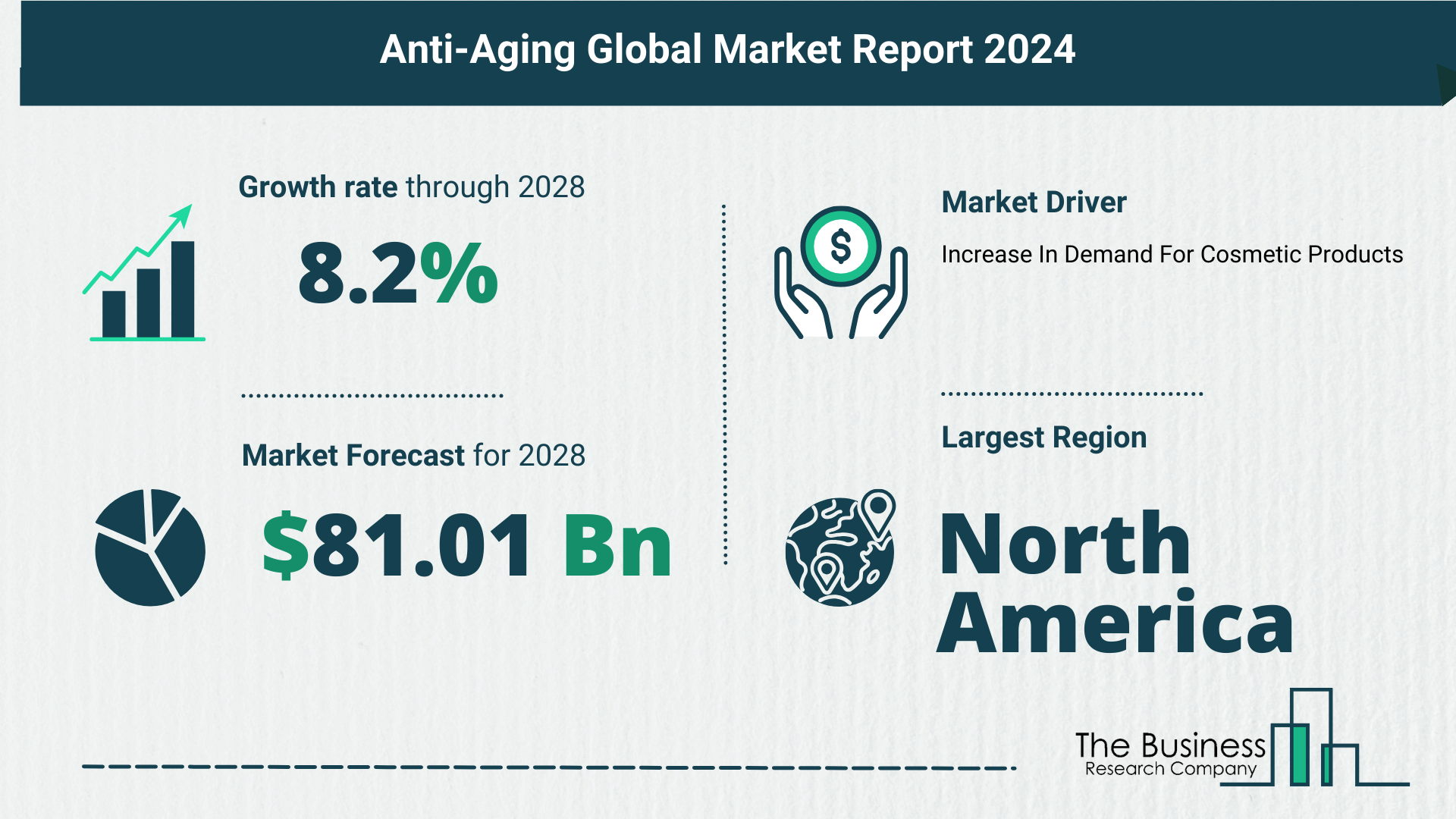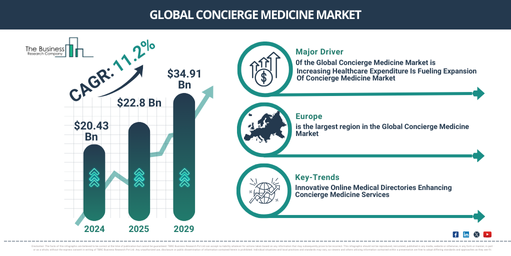Comprehensive Analysis On Size, Share, And Drivers Of The Anti-Aging Market
The Business Research Company’s global market reports provide comprehensive analysis on the various markets in 27 industries across 60 geographies.
The anti-aging market has witnessed robust growth in recent years, reflecting the increasing demand for solutions that defy the signs of aging. With a market size of $54.66 billion in 2023, projected to reach $59.17 billion in 2024 at a CAGR of 8.2%, the industry is on a steadfast upward trajectory. This growth is attributed to several factors, including an aging population, heightened consumer awareness of anti-aging products, a surge in disposable income, an expanding skincare and cosmetics industry, and shifting demographics.
A Glimpse into the Future
Anticipating Strong Growth
The anti-aging market is poised for continued robust growth, with an estimated market size of $81.01 billion in 2028, boasting a CAGR of 8.2%. The forecasted expansion is driven by factors such as the rising demand for non-invasive solutions, a growing preference for natural and organic products, increasing demand for clinically-advanced solutions, rising disposable income and healthcare expenditure, and a growing awareness and acceptance of anti-aging products and services. Notable trends in the forecast period include advancements in medical and cosmetic technologies, the development of nutraceuticals and functional foods, the convergence of beauty and wellness trends, and the rise of digital beauty platforms and virtual consultations.
- Key Trends in the Forecast Period
- Advancements in medical and cosmetic technologies
- Development of nutraceuticals and functional foods
- Convergence of beauty and wellness trends
- Rise of digital beauty platforms and virtual consultations
Rising Disposable Income Fuels Market Growth
The surge in disposable income emerges as a driving force behind the escalating growth of the anti-aging market. As households experience an increase in disposable income, consumers have more financial freedom to allocate towards premium anti-aging products and treatments. The higher affordability translates into a heightened demand for top-tier solutions, thereby propelling market growth. For instance, in 2021, lower-middle-income countries had a per capita net disposable income ranging from $1,036 to $4,045, while upper-middle-income countries ranged from $4,046 to $12,535, according to the World Bank.
- Market Players: Allergan plc, L’Oréal SA, Beiersdorf AG, Estee Lauder Companies Inc., Procter & Gamble Company, Shiseido Co. Ltd., and others.
View More On The Anti-Aging Market Report 2024 – https://www.thebusinessresearchcompany.com/report/anti-aging-global-market-report
Innovations Transforming the Landscape
Major companies in the anti-aging market are continually innovating to gain a competitive edge. A notable example is the development of new anti-aging masks, exemplified by Christian Dior SE’s launch of the Dior Skin Light. This anti-aging LED mask utilizes photobiomodulation technology with red light to stimulate skin cells, enhancing collagen and elastin production. With a promise of addressing issues such as redness, enlarged pores, and excessive sebum in just twelve minutes, innovations like these are transforming the anti-aging market landscape.
- Innovation Spotlight: Christian Dior SE’s launch of Dior Skin Light, an anti-aging LED mask.
Strategic Acquisitions Strengthen Industry Players
In January 2022, Galderma S. A. acquired ALASTIN Skincare, Inc., marking a strategic move to strengthen its dermatology portfolio. ALASTIN Skincare, a US-based company specializing in physician-dispensed skincare products, brings expertise in science-based skincare to Galderma, solidifying its position in the global skincare market.
- Strategic Acquisition: Galderma S. A.’s acquisition of ALASTIN Skincare, Inc.
Market Segmentation: A Comprehensive Overview
The anti-aging market is segmented based on product type, treatment, demographic, application, and end-user categories, providing a holistic understanding of its diverse landscape.
- Product Type
- UV Absorbers
- Anti-Wrinkle Products
- Dermal Fillers
- Botox
- Anti-Stretch Mark Products
- Treatment
- Hair Restoration
- Adult Acne Therapy
- Breast Augmentation
- Liposuction
- Chemical Peel
- Other Treatments
- Demographic
- Generation X
- Baby Boomers
- Generation Y
- Generation Z
- Application
- Anti-Wrinkle Treatment
- Anti-Pigmentation
- Skin Resurfacing
- Other Applications
- End-User
- Hospitals
- Clinics
- Home Healthcare
Regional Dynamics: North America Leads, Asia-Pacific Emerges
In 2023, North America dominated the anti-aging market, but the forecast indicates that Asia-Pacific is set to be the fastest-growing region. This shift in regional prominence signifies the global nature of the anti-aging market’s evolution.
Conclusion: Radiant Horizons Await
From $54.66 billion in 2023 to a projected $81.01 billion in 2028, the anti-aging market’s trajectory promises a radiant future. Fueled by consumer trends, technological innovations, and strategic industry moves, the market continues to redefine the boundaries of beauty and wellness. As the convergence of health and aesthetics gains momentum, the anti-aging market stands at the forefront of transformative change, offering a spectrum of possibilities for those seeking to defy the hands of time.
Request A Sample Of The Global Anti-Aging Market Report 2024:
https://www.thebusinessresearchcompany.com/sample_request?id=5842&type=smp



